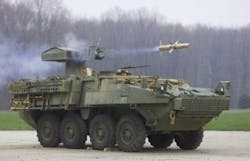Army seeks to enhance wide-area-networking vetronics in its fleets of armored combat vehicles
The next logical step, officials believe, is to provide this information to others on Army wide-area tactical networks by adding networking and protection capability on each vehicle -- including router function, network encryption, computer firewall, intrusion prevention and detection, and physical, electrical, and logical connections to the vehicle local area network (LAN).
Network interfaces would be defined according to the Army's Vehicular Integration for C4ISR/EW Interoperability (VICTORY) standard specification version 1.0 and the military data radios that provide wide-area networking.
Proposers must optimize their solutions for size, weight, and power (SWAP), as well as to operate reliably in the shock, vibration, dust, sand, and temperature extremes of ground combat vehicles, Army officials say. Proposals also should be integrated into current and existing vetronics architectures, rather than bolt-on systems that not only can limit effectiveness, but also increase operator and training workloads. Information-assurance capability should be part any proposed solution.
The router should support all networking protocols and functions necessary to modern combat vehicles, and network encryption should be High Assurance Internet Protocol Encryptor Interoperability Specification (HAIPE-IS) Version 3.0.2 certified or certifiable with an evolution to the HAIPSEC standard in the future.
The firewall and intrusion-prevention and -detection systems functions should comply with common criteria protection profiles -- at a minimum the approved firewall protection profile V2.0 and network intrusion prevention protection V1.1). The router at least should support Internet Engineering Task Force (IETF) RFC 1812, requirements for IP Version 4 Router. All functions must comply with Internet Protocol (IP) Version 4 and capable of IP V6.
Companies interested in providing pertinent information should respond no later than 26 Sept. 2011. Responses should include the company's cryptographic certification status. Proposals should include target environmental performance; resistance to electro-magnetic interference; general description of design architecture; size weight and power consumption; expected cost; data throughput and latency; a maintenance approach; and training expectations.
Submit responses shorter than 50 pages by e-mail to the Army's Nai'im Bilaal at [email protected]. More information is online at https://www.fbo.gov/notices/8727d4d2d50b52e8a9295fe5d9160e85.
Related stories
-- Warfighters call for innovative, responsive, and reliable vetronics in combat vehicles.
